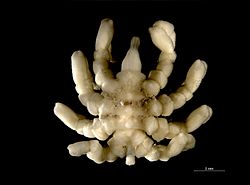| Pycnogonum | |
|---|---|
 | |
| Pycnogonum litorale | |
| Scientific classification | |
| Kingdom: | Animalia |
| Phylum: | Arthropoda |
| Subphylum: | Chelicerata |
| Class: | Pycnogonida |
| Order: | Pantopoda |
| Family: | Pycnogonidae |
| Genus: | Pycnogonum Brünnich, 1764 [1] |
| Species | |
See text | |
Pycnogonum is a genus of sea spiders in the family Pycnogonidae. It is the type genus of the family. [2]